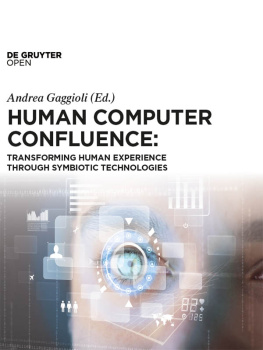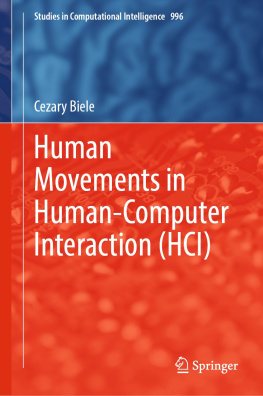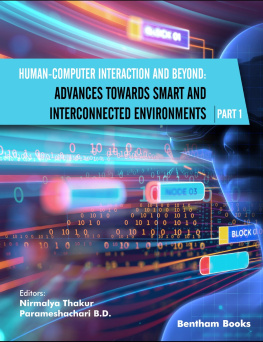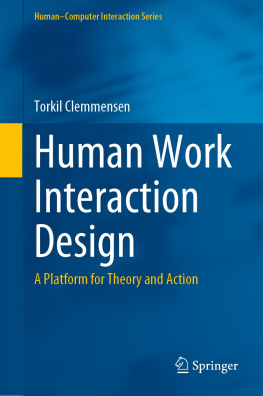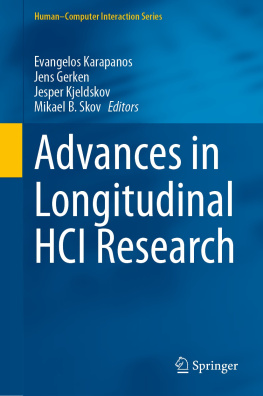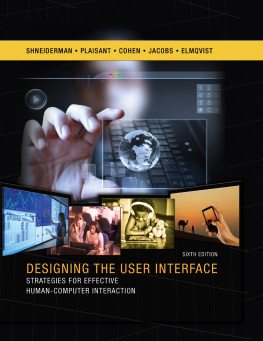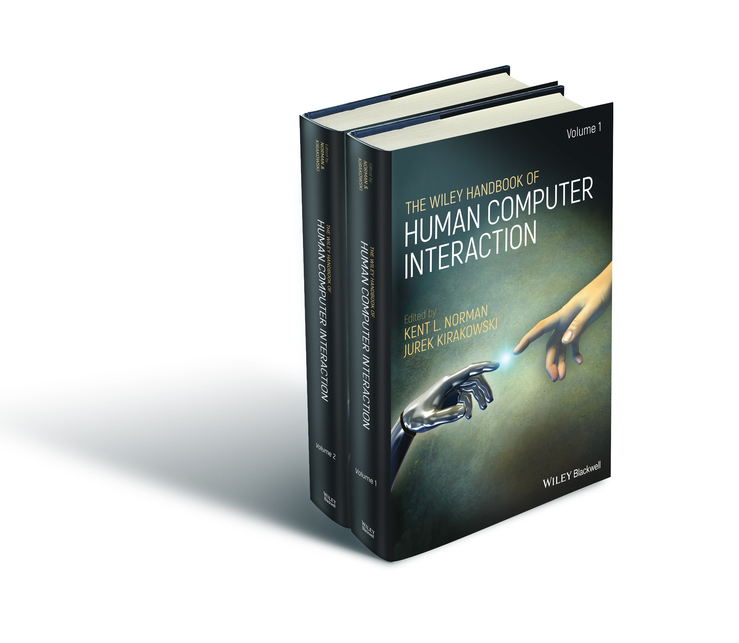
Table of Contents
List of Tables
- Chapter 03
- Chapter 08
- Chapter 10
- Chapter 11
- Chapter 12
- Chapter 13
- Chapter 14
- Chapter 16
- Chapter 17
- Chapter 19
- Chapter 21
- Chapter 22
- Chapter 24
- Chapter 26
- Chapter 29
- Chapter 35
- Chapter 37
- Chapter 40
- Chapter 42
List of Illustrations
- Chapter 01
- Chapter 02
- Chapter 03
- Chapter 04
- Chapter 05
- Chapter 06
- Chapter 08
- Chapter 09
- Chapter 11
- Chapter 12
- Chapter 15
- Chapter 16
- Chapter 17
- Chapter 18
- Chapter 19
- Chapter 20
- Chapter 21
- Chapter 22
- Chapter 23
- Chapter 24
- Chapter 25
- Chapter 26
- Chapter 28
- Chapter 30
- Chapter 33
- Chapter 34
- Chapter 35
- Chapter 37
- Chapter 40
- Chapter 43
- Chapter 44
Guide
Pages
The Wiley Handbook of Human Computer Interaction
Volume 1
Edited by
Kent L. Norman and Jurek Kirakowski
This edition first published 2018
2018 John Wiley & Sons Ltd
All rights reserved. No part of this publication may be reproduced, stored in a retrieval system, or transmitted, in any form or by any means, electronic, mechanical, photocopying, recording or otherwise, except as permitted by law. Advice on how to obtain permission to reuse material from this title is available at http://www.wiley.com/go/permissions.
The right of Kent L. Norman and Jurek Kirakowski to be identified as authors of the editorial material in this work has been asserted in accordance with law.
Registered Office(s)
John Wiley & Sons, Inc., 111 River Street, Hoboken, NJ 07030, USA
John Wiley & Sons Ltd, The Atrium, Southern Gate, Chichester, West Sussex, PO19 8SQ, UK
Editorial Office
The Atrium, Southern Gate, Chichester, West Sussex, PO19 8SQ, UK
For details of our global editorial offices, customer services, and more information about Wiley products visit us at www.wiley.com.
Wiley also publishes its books in a variety of electronic formats and by printondemand. Some content that appears in standard print versions of this book may not be available in other formats.
Limit of Liability/Disclaimer of Warranty
While the publisher and authors have used their best efforts in preparing this work, they make no representations or warranties with respect to the accuracy or completeness of the contents of this work and specifically disclaim all warranties, including without limitation any implied warranties of merchantability or fitness for a particular purpose. No warranty may be created or extended by sales representatives, written sales materials or promotional statements for this work. The fact that an organization, website, or product is referred to in this work as a citation and/or potential source of further information does not mean that the publisher and authors endorse the information or services the organization, website, or product may provide or recommendations it may make. This work is sold with the understanding that the publisher is not engaged in rendering professional services. The advice and strategies contained herein may not be suitable for your situation. You should consult with a specialist where appropriate. Further, readers should be aware that websites listed in this work may have changed or disappeared between when this work was written and when it is read. Neither the publisher nor authors shall be liable for any loss of profit or any other commercial damages, including but not limited to special, incidental, consequential, or other damages.
Library of Congress CataloginginPublication Data Is Available
9781118976135 Hardback
9781118977262 ePDF
9781118977279 ePub
Cover Design: Wiley
Cover Image: Andrea Danti/Shutterstock
Notes on Contributors
Marc Abrams serves as Harmonias president and chief technical officer. He provides technical and business leadership to the company and manages all its technical projects. In the past, Dr. Abrams has been with the former U.S. Army Concepts Analysis Agency, a postdoc in the Distributed Operating Systems group in Stanfords Computer Science Department, and a visiting scientist in the network protocol group at IBMs Zurich Research Laboratory in Switzerland. He has been the principal investigator for over $30 million in research and development projects with the Air Force, the Army, DARPA, DHS, DOE, DOT, NASA, the Navy, NIH, NSF, MDA, ONR, OSD, and various companies including General Dynamics, IBM, Northrop Grumman, Raytheon, and Leidos. He received his PhD from the University of Maryland at College Park in computer science. Before Harmonia, Dr. Abrams was a tenured associate professor at Virginia Tech, where his research on humancomputer interfaces (HCI) led to the creation of User Interface Markup Language (UIML) and later the cofounding of Harmonia. UIML forms the basis for Harmonias LiquidApps product. At Virginia Tech, he also cofounded the Center for Human Computer Interaction, and worked with the HCI faculty in fields ranging from cognitive psychology to human factors on scenariodriven HCI design.
Nigel Bevan is an independent user experience (UX) consultant with wide industrial and research experience. He has been the editor of several international standards including both the original and revised versions of ISO 924111 (usability), 9241210 (humancentered design processes), 25010 and 25022 (software quality model and measures), 202822 (usability test method), and 25063 (context of use). He has authored over 80 publications and was a member of the U.S. National Academy of Science Committee on HumanSystem Design Support for Changing Technology.
Frdric Bevilacqua is the head of the Sound Music Movement Interaction team at Institute for Research and Coordination in Acoustics/Music (IRCAM) in Paris, which is part of the joint research lab Science and Technology for Music and Sound (IRCAMCNRSUniversit Pierre et Marie Curie). He received his PhD in Biomedical Optics from EPFL (Swiss Federal Institute of Technology in Lausanne), in 1998. His research concerns the modeling and the design of interaction between movement and sound, and the development of gesturebased interactive systems. With his team, he developed several digital musical instruments such as the augmented violin and the modular musical objects (First Prize of the Guthman Musical Instrument Competition), and developed several systems to synchronize motion to sound, such as the gesture follower. He coauthored more than 120 scientific publications and coauthored five patents. He was keynote or invited speaker at several international conferences such as the ACM TEI13. As the coordinator of the Interlude Project he received the ANR Digital Technology Prize (Societal Impact) in 2013.
Nadia BianchiBerthouze is a full professor in affective computing and interaction at the Interaction Centre of the University College London (UCL). She received her PhD in computer science for biomedicine from the University of the Studies of Milan, Italy. Her research focuses on designing technology that can sense the affective state of its users and use that information to tailor the interaction process. She has pioneered the field of affective computing and for more than a decade she has investigated body movement, and more recently touch behavior, as a means to recognize and measure the quality of the user experience in fullbody computer games, physical rehabilitation, and textile design. She also studies how fullbody technology and body sensory feedback can be used to modulate peoples perception of themselves and of their capabilities to improve selfefficacy and copying capabilities. She has published more than 170 papers in affective computing, HCI, and pattern recognition. She was awarded the 2003 Technical Prize from the Japanese Society of Kansei Engineering and she has given a TEDxStMartin talk (2012).
Next page


